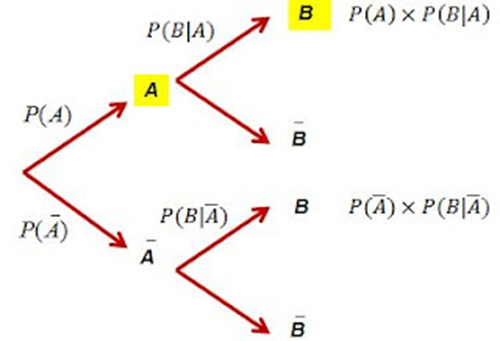Before presenting Bayes' theorem,
it’s helpful to recall the definition of conditional probability to highlight
the difference between this concept and the theorem itself.
❗ Definition
The conditional probability of an
event B given that event A has occurred is the chance of B happening under the
condition that A has already occurred. It is denoted by P(B∣A), read as “the
probability of B given A”.
🔸 A and B are dependent events.
🔸 Event A occurs before event B.
🛑 Example
An urn contains five balls that differ only by color: two red and three blue. Two balls are drawn without replacement, one after the other.
Question: What is the probability that the second ball is red, given that the
first was blue?
A tree diagram helps visualize the possible outcomes in this situation. All
conditional probabilities are shown, and the answer to the question is
highlighted in yellow.

❗ BAYES' THEOREM
⚠️ P(B∣A) and P(A∣B) may look
similar, but they represent different ideas. Consider the following examples:
1. Let A = “has technical
training”; B = “performs good service”.
🔸 P(B∣A): probability of performing good service given technical
training.
🔸 P(A∣B): probability of having technical training given that good
service was performed.
2. Let A = “was a good student in
high school”; B = “passed the college entrance exam”.
🔸 P(B∣A): probability of passing the exam given that the person was a
good student.
🔸 P(A∣B): probability of having been a good student given that the
person passed the exam.
These pairs of probabilities often
appear in real-life problems. Now let’s find a formula to calculate P(A∣B). From:
Bayes’ Theorem:
🔔 Interpretation
Bayes’ Theorem reverses the order of information:
• Conditional probability deals with P(B∣A): probability of B occurring given A occurred.
• Bayes’ Theorem addresses P(A∣B): probability of A occurring given B occurred — that is, the reverse of conditional probability.
🛑 Example – Applying
Bayes’ Theorem
Let’s revisit the urn example, but now with a different question:
Question: What is the probability that the first ball drawn was blue, given
that the second was red?
• Red then Red (R–R)
The event of interest is: first blue given second red.
Answer: Using Bayes’ Theorem, the probability the first ball was blue given the second is red is 3/4, ou 75%.
🛑 Example – Breathalyzer Test
In a city, the breathalyzer test is
mandatory.
• 25% of drivers drink before driving.
• Of those who drink, 99% test positive.
• Of those who do not drink, 17% also test positive.
Question: If a driver tests positive, what is the chance they actually consumed
alcohol?
Let the events be:
• B: drinks
• NB: does not drink
• + : positive test
Compute P(B∣+) using the given data.
🛑 Example – Horse Race
• In 12 previous races, White won 5 times and Black 7.
• In 3 of White’s 5 victories, it was raining.
• In 1 of Black’s 7 victories, it was also raining.
Question: It is raining now. What is the probability that White will win?
- "Bayes’
Theorem is powerful because it lets us update probabilities with new
evidence. Remember: it ‘reverses’
the condition!"











No comments:
Post a Comment